Politics of England
| This article is part of a series within the Politics of the United Kingdom on the |
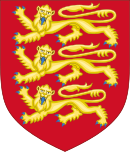 |
|---|
The Politics of England forms the major part of the wider politics of the United Kingdom, with England being more populous than all the other countries of the United Kingdom put together. As England is also by far the largest in terms of area and GDP, its relationship to the UK is somewhat different from that of Scotland, Wales or Northern Ireland. The English capital London is also the capital of the UK, and English is the dominant language of the UK (not officially, but de facto). Dicey and Morris (p26) list the separate states in the British Islands. "England, Scotland, Northern Ireland, the Isle of Man, Jersey, Guernsey, Alderney, and Sark.... is a separate country in the sense of the conflict of laws, though not one of them is a State known to public international law." But this may be varied by statute.
The United Kingdom is one state for the purposes of the Bills of Exchange Act 1882. Great Britain is a single state for the purposes of the Companies Act 1985. Traditionally authors referred to the legal unit or state of England and Wales as "England" although this usage is becoming politically unacceptable in the last few decades. The Parliament of the United Kingdom is located in London, as is its civil service, HM Treasury and most of the official residences of the monarchy. In addition, the state bank of the UK is known as the "Bank of England".
Though associated with England for some purposes, the Isle of Man, Jersey and Guernsey have their own parliaments, and are not part of the United Kingdom, the European Union or England.
Prior to the Union, in 1707, England was ruled by a monarch and the Parliament of England. Since the Union, England has not had its own government.

History
Pre-Union politics

The English Parliament traces its origins to the Anglo-Saxon Witenagemot. Hollister argues that:
- In an age lacking precise definitions of constitutional relationships, the deeply ingrained custom that the king governed in consultation with the Witan, implicit in almost every important royal document of the period, makes the Witenagemot one of Anglo-Saxon England's fundamental political institutions.[1]
In 1066, William of Normandy brought a feudal system, where he sought the advice of a council of tenants-in-chief and ecclesiastics before making laws. In 1215, the tenants-in-chief secured the Magna Carta from King John, which established that the king may not levy or collect any taxes (except the feudal taxes to which they were hitherto accustomed), save with the consent of his royal council, which slowly developed into a parliament.
In 1265, Simon de Montfort, 6th Earl of Leicester summoned the first elected Parliament. The franchise in parliamentary elections for county constituencies was uniform throughout the country, extending to all those who owned the freehold of land to an annual rent of 40 shillings (Forty-shilling Freeholders). In the boroughs, the franchise varied across the country; individual boroughs had varying arrangements.
This set the scene for the so-called "Model Parliament" of 1295 adopted by Edward I. By the reign of Edward II, Parliament had been separated into two Houses: one including the nobility and higher clergy, the other including the knights and burgesses, and no law could be made, nor any tax levied, without the consent of both Houses as well as of the Sovereign.
The Laws in Wales Acts of 1535–42 annexed Wales as part of England and brought Welsh representatives to Parliament.
When Elizabeth I was succeeded in 1603 by the Scottish King James VI, (thus becoming James I of England), the countries both came under his rule but each retained its own Parliament. James I's successor, Charles I, quarrelled with the English Parliament and, after he provoked the Wars of the Three Kingdoms, their dispute developed into the English Civil War. Charles was executed in 1649 and under Oliver Cromwell's Commonwealth of England the House of Lords was abolished, and the House of Commons made subordinate to Cromwell. After Cromwell's death, the Restoration of 1660 restored the monarchy and the House of Lords.
Amidst fears of a Roman Catholic succession, the Glorious Revolution of 1688 deposed James II (James VII of Scotland) in favour of the joint rule of Mary II and William III, whose agreement to the English Bill of Rights introduced a constitutional monarchy, though the supremacy of the Crown remained. For the third time, a Convention Parliament, i.e., one not summoned by the king, was required to determine the succession.
Post-Union politics

- Treaty of Union agreed by commissioners for each parliament on 22 July 1706.
- Acts of Union 1707, passed by both the Parliament of England and the Parliament of Scotland to form the Kingdom of Great Britain.
- Act of Union 1800, passed by both the Parliament of Great Britain and the Parliament of Ireland to form the United Kingdom of Great Britain and Ireland.
Once the terms of the Treaty of Union were agreed in 1706, Acts of Union were passed in both the Parliament of England and the Parliament of Scotland, which created a new Kingdom of Great Britain. The Acts dissolved both parliaments, replacing them with a new Parliament of the Kingdom of Great Britain based in the former home of the English parliament. All the traditions, procedures, and standing orders of the English parliament were retained, as were the incumbent officers, and English members comprised the overwhelming majority of the new body. It was not even considered necessary to hold a new general election. While Scots law and Scottish legislation remained separate, new legislation for both former kingdoms was now dealt with by the new parliament.
After the Hanoverian George I ascended the throne in 1714 through an Act of Parliament, power began to shift from the Sovereign, and by the end of his reign the position of the ministers — who had to rely on Parliament for support — was cemented. Towards the end of the 18th century the monarch still had considerable influence over Parliament, which was dominated by the English aristocracy and by patronage, but had ceased to exert direct power: for instance, the last occasion Royal Assent was withheld, was in 1708 by Queen Anne. At general elections the vote was restricted to freeholders and landowners, in constituencies that were out of date, so that in many "rotten boroughs" seats could be bought while major cities remained unrepresented. Reformers and Radicals sought parliamentary reform, but as the Napoleonic Wars developed the government became repressive against dissent and progress toward reform was stalled.
Post-devolution politics

Since Scotland, Wales and Northern Ireland voted for devolved legislatures in referendums in 1997 and 1998 (see Scottish devolution referendum, 1997, Welsh devolution referendum, 1997, and Northern Irish Belfast Agreement referendum, 1998), there have been numerous debates about England's position within the United Kingdom.
The Scottish Parliament, National Assembly for Wales and Northern Ireland Assembly were created by the UK parliament along with strong support from the majority of people of Scotland, Wales and Northern Ireland, and are not yet independent of the rest of the United Kingdom. However, this gave each country a separate and distinct political identity, leaving England (83% of the UK population) as the only part of the UK directly ruled in nearly all matters by the UK government in London, although London itself is devolved (see below).
While Scotland and Northern Ireland have always had separate legal systems to England (see Scots law and Northern Ireland law), this has not been the case with Wales (see English law, Welsh law and Contemporary Welsh Law). However, laws concerning the Welsh language, and also the National Assembly for Wales, have created differences between the law in Wales, and the law in England, as they apply in Wales and not in England.
Regarding parliamentary matters, an anomaly called the West Lothian Question has come to the fore as a result of legislative devolution for Scotland, Wales and Northern Ireland without corresponding legislative devolution for England. Before devolution, for example, purely 'Scottish' legislation was debated at Westminster in a Scottish Grand Committee composed of just those MPs representing Scottish constituencies.
However, legislation was still subject to a vote of the entire House of Commons and this frequently led to legislation being passed despite the majority of Scottish MPs voting against. (This was especially true during the period of Conservative rule from 1979 to 1997 when the Conservative Party had an overall majority of MPs but only a handful representing Scotland and Wales.) Now that many Scottish matters are dealt with by the Scottish Parliament, the fact that MPs representing Scotland and Wales can not vote on those issues as they affect Scotland, but can vote on those same issues as they affect England is causing some disquiet.
The Campaign for an English Parliament is a notable proponent of a separate English parliament.
England in the Parliament of the United Kingdom

The Parliament of the United Kingdom is located at Westminster in London.
The House of Commons
English members of parliament are elected at the same time as those for the rest of the UK. There are 533 English constituencies. Because of their large number, they form an inbuilt majority in the House of Commons. Even though Clause 81 of the Scotland Act 1998 equalised the English and Scottish electoral quota, and thereby reduced the number of Scottish members in the House of Commons from 72 to 59 MPs.
English Grand Committee
For many years an anomaly known as the West Lothian question where MPs from Scotland, Wales and Northern Ireland are able to vote on matters which only effect England only when those same issues are devolved to their own institutions and has become a major issue in recent years. In May 2015 the Conservative Party won an unexpected overall majority and pledged to commit to a manifesto promise to change parliamentary procedures and create an English Grand Committee to give English MPs a much greater role in issues which only effect England or England and Wales as a solution to this issue known as "English Votes for English Laws" (EVEL). On 22 October 2015 following a heated debate in the House of Commons the Conservative Government led by David Cameron by 312 votes to 270 votes approved the proposals which came into effect immediately.[2]
The House of Lords
The House of Lords also has an inbuilt English majority.
Members of the House of Lords who sit by virtue of their ecclesiastical offices are known as the Lords Spiritual. Formerly, the Lords Spiritual comprised a majority in the House of Lords, including the Church of England's archbishops, diocesan bishops, abbots, and priors. After 1539, however, only the archbishops and bishops continued to attend, for the Dissolution of the Monasteries suppressed the positions of abbot and prior. In 1642, during the English Civil War, the Lords Spiritual were excluded altogether, but they returned under the Clergy Act 1661.
The number of Lords Spiritual was further restricted by the Bishopric of Manchester Act 1847, and by later acts. Now, there can be no more than 26 Lords Spiritual in the Lords, but they always include the five most important prelates of the Church: the Archbishop of Canterbury, the Archbishop of York, the Bishop of London, the Bishop of Durham, and the Bishop of Winchester. Membership of the House of Lords also extends to the 21 longest-serving other diocesan bishops of the Church of England. The current Lords Spiritual, therefore, represent only the Church of England, although members of other churches and religions are appointed by the Queen as individuals and not ex officio.
England in the Parliament of the European Union
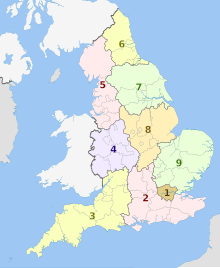
While Scotland, Wales and Northern Ireland are each treated as single European Parliament constituencies, England itself gets nine European constituencies, out of a total of twelve UK constituencies. Gibraltar, the only British Overseas Territory that is also part of the European Union, is included in South West England. The current English European constituencies are
| Constituency | Region | Seats | Pop. | per Seat |
|---|---|---|---|---|
| 1. London | Greater London | 9 | 7.4m | 822k |
| 2. South East England | South East | 10 | 8m | 800k |
| 3. South West England | South West, Gibraltar | 7 | 4.9m | 700k |
| 4. West Midlands | West Midlands | 7 | 5.2m | 740k |
| 5. North West England | North West | 9 | 6.7m | 745k |
| 6. North East England | North East | 3 | 2.5m | 833k |
| 7. Yorkshire and the Humber | Yorkshire and the Humber | 6 | 4.9m | 816k |
| 8. East Midlands | East Midlands | 6 | 4.1m | 683k |
| 9. East of England | East of England | 7 | 5.4m | 770k |
'England only' departments of the British Government
Several departments of the British Government have responsibilities for matters affecting England alone:
- The Department for Communities and Local Government.
- The Department for Education is responsible for issues affecting people in England up to the age of 19.
- The Department for Environment, Food and Rural Affairs (Defra) is responsible for environmental protection, food production and standards, agriculture, fisheries and rural communities in England.
- The Department of Health, (DoH) has responsibility for government policy on health, social care and the English National Health Service (NHS).
- The Office for Standards in Education, Children's Services and Skills (Ofsted) which is a non-ministerial department headed by Her Majesty's Chief Inspector of Schools in England.
Other departments deal mainly with matters affecting England though they also have some UK wide responsibilities in certain areas;
Devolution within England
Greater London Authority

Greater London has a certain amount of devolution, with the London Assembly and the directly elected Mayor of London. The Assembly was established on 3 July 2000, after a referendum in which 72% of those voting supported the creation of the Greater London Authority, which included the Assembly along with the Mayor of London. The referendum and establishment were largely contigious with Scottish and Welsh devolution.
In Greater London, the 32 London borough councils have a status close to that of unitary authorities, but come under the Greater London Authority, which oversees some of the functions performed elsewhere in England by Counties including transport, policing, the fire brigade and also economic development.
The Mayor of London is also referred to as the "London Mayor", a form which helps to avoid confusion with the Lord Mayor of the City of London, the ancient and now mainly ceremonial role in the City of London. The Mayor of London is mayor of Greater London, which has a population of over 7.5 million while the City of London is only a small part of the modern city centre and has a population of less than 10,000.
There is also a London political party, One London, which was represented in the assembly from 2005-8, and is eurosceptic, with roots in the United Kingdom Independence Party (UKIP) and Veritas.
Former regional assemblies
After power was to be devolved to Scotland, Northern Ireland and Wales without a counterweight in England, a series of referendums were planned to establish elected regional assemblies in some of the regions. The first was held in London in 1998 and was passed. The London Assembly and Mayor of London of the Greater London Authority were created in 2000. A referendum was held in North East England on 4 November 2004 but the proposal for an elected assembly was rejected. Plans to hold further referendums in other regions were then cancelled. The remaining eight Partnership Regional Assemblies were abolished in 2010 as part of a Sub-National Review of Economic Development and Regeneration with most of their functions transferring to the relevant Regional Development Agency and to Local Authority Leaders' Boards.[3]
There was some inconsistency in the naming of the individual assemblies. They were:
- East of England Regional Assembly
- East Midlands Regional Assembly
- North East Assembly
- North West Regional Assembly
- South East England Regional Assembly
- South West Regional Assembly
- West Midlands Regional Assembly
- Yorkshire and Humber Assembly
Each assembly corresponded to a region of England:
Status of Cornwall
Most English people and the UK government regard Cornwall as a county of England, but Cornish nationalists believe that the Duchy of Cornwall has a status deserving greater autonomy. Campaigners including Mebyon Kernow, a Cornish nationalist party, and all five Cornish Liberal Democrat MPs oppose participation in the South West Regional Assembly alongside Devon, Dorset, Gloucestershire, Somerset and Wiltshire in favour of a democratically elected Cornish Assembly.[4][5][6]
Local government
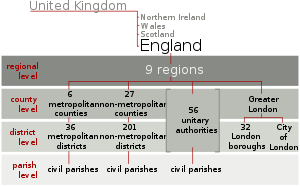

London borough
unitary authority
two-tier non-metropolitan county
For the purposes of local government, England is divided into as many as four levels of administrative divisions. At some levels, various legislation has created alternative types of administrative division.
Districts in England may also have the status of borough, city or royal borough.
The metropolitan counties were divided into metropolitan districts which are usually called boroughs. When the county councils were abolished the metropolitan districts gained much of their powers and therefore function similar to other unitary authorities.
Shire counties are divided into non-metropolitan districts. Power is shared with the county council, but shared differently from the metropolitan counties when first created.
The civil parish is the most local unit of government in England. Under the legislation that created Greater London, they are not permitted within its boundary. Not all of the rest of England is parished, though the number of parishes and total area parished is growing.
English political parties
Most of the parties that operate within England alone tend to be purely interested in English issues. Examples include the English Democrats Party (although they too have stood candidates in Monmouthshire), One England, the English People's Party, the English Radical Alliance, the England First Party, and the English Independence Party.
The Green Party has had an amicable split from Scottish counterpart, and the Wales Green Party section is becoming increasingly autonomous.
The Conservative Party has adopted a policy of English Votes on English Legislation (EVoEL). The Conservative policy of EVoEL aims to prevent MPs with constituencies outside of England from voting on legislation that only affects England. There is a significant element within the Conservative Party that supports full devolution for England with the establishment of a devolved English Parliament and English Executive, along the lines of those in Scotland.
Some English people and parties go further by calling for the dissolution of the Union entirely, such as One England, the English Independence Party and the English Radical Alliance. However, the approach favoured by the current Labour government was (on the basis that England is too large to be governed as a single sub-state entity) to propose the devolution of power to the Regions of England. Lord Falconer claimed a devolved English parliament would dwarf the rest of the United Kingdom.[7] Referendums would decide whether people wanted to vote for regional assemblies to watch over the work of the non-elected RDAs.
Church of England
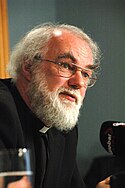
The Church of England is the officially established Christian church[8] in England. Queen Elizabeth II is the official head of the church, with the title Supreme Governor of the Church of England, while the Archbishop of Canterbury is the head clergyman. The canon law of the Church of England states, "We acknowledge that the Queen’s most excellent Majesty, acting according to the laws of the realm, is the highest power under God in this kingdom, and has supreme authority over all persons in all causes, as well ecclesiastical as civil." In practice this power is often exercised through Parliament and the Prime Minister.
Of the forty-four diocesan archbishops and bishops in the Church of England, only twenty-six are permitted to sit in the House of Lords. The Archbishops of Canterbury and York automatically have seats, as do the Bishops of London, Durham and Winchester. The remaining twenty-one seats are filled in order of seniority by consecration. It may take a diocesan bishop a number of years to reach the House of Lords, at which point he becomes a Lord Spiritual.[9]
Status of Monmouthshire
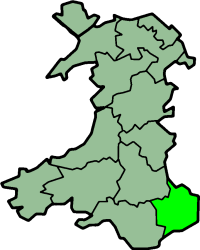
The historic county of Monmouthshire, lying in the Welsh Marches (the Anglo-Welsh border), is a bone of contention for some English nationalists.[10] Although the county is now mostly in Wales, to add to the confusion, Welsh Bicknor was an exclave of the county, and is in Herefordshire (England). The Welsh Border has historically been more fluid than the Anglo-Scottish border
Monmouthshire's Welsh status was ambiguous until relatively recently, with it often thought of as part of England. The entirety of Wales was made part of the Kingdom of England by the Statute of Rhuddlan, but did not adopt the same civil governance system, with the area of Monmouthshire being under the control of Marcher Lords.
The Laws in Wales Act 1535 integrated Wales directly into the English legal system and the "Lordships Marchers within the said Country or Dominion of Wales" were allocated to existing and new shires. Some lordships were annexed to existing counties in England and some were annexed to existing counties in Wales, with the remainder being divided up into new counties. Despite Monmouthshire being a new county, it was given two Knights of the Shire in common with existing counties in England, rather than one as in the counties in Wales.
The relevant section of the Act states that "one Knight shall be chosen and elected to the same Parliaments for every of the Shires of Brecknock, Radnor, Montgomery and Denbigh, and for every other Shire within the said Country of Dominion of Wales". As Monmouthshire was dealt with separately it cannot be taken to be a shire "within the said Country of Dominion of Wales". The Laws in Wales Act 1542 specifically enumerates the Welsh counties as twelve in number, excluding Monmouthshire from the count.
The issue was finally clarified in law by the Local Government Act 1972, which provided that "in every act passed on or after 1 April 1974, and in every instrument made on or after that date under any enactment (whether before, on or after that date) "Wales", subject to any alterations of boundaries..." included "the administrative county of Monmouthshire and the county borough of Newport".[11] The name passed onto a district of Gwent between 1974 and 1996, and on 1 April 1996, a local government principal area named Monmouthshire, covering the eastern 60% of the historic county, was created.
However, the issue has not gone completely away, and the English Democrats nominated candidates for the 2007 Welsh Assembly elections in three of six constituencies in the area of the historic county with a view to promoting a referendum on 'Letting Monmouthshire Decide' whether it wished to be part of Wales or England.[12] The party received between 2.2% and 2.7% of the vote (a much lower total than Plaid Cymru) and failed to have any members elected.[13]
An example of a former Welsh exclave in England is Welsh Bicknor.
Status of Berwick-upon-Tweed

The status of Berwick, north of the River Tweed is controversial, especially amongst Scottish nationalists.[14] Berwick remained a county in its own right until 1885, when it was included in Northumberland for Parliamentary purposes. The Interpretation Act 1978 provides that in legislation passed between 1967 and 1974, "a reference to England includes Berwick upon Tweed and Monmouthshire".
In 2008, SNP MSP Christine Grahame made calls in the Scottish Parliament for Berwick to become part of Scotland again, saying
- "Even the Berwick-upon-Tweed Borough Council leader, who is a Liberal Democrat, backs the idea and others see the merits of reunification with Scotland."[15]
However, Alan Beith, the Liberal Democrat MP for Berwick, said the move would require a massive legal upheaval and is not realistic.[16] However he is contradicted by another member of his party, the Liberal Democrat MSP Jeremy Purvis, who was born and brought up in Berwick. Purvis has asked for the border to be moved twenty miles south (i.e., south of the Tweed) to include Berwick borough council rather than just the town, and has said:
- "There’s a strong feeling that Berwick should be in Scotland, Until recently, I had a gran in Berwick and another in Kelso, and they could see that there were better public services in Scotland. Berwick as a borough council is going to be abolished and it would then be run from Morpeth, more than 30 miles away.".[17]
According to a poll conducted by a TV company, 60% of residents favoured Berwick rejoining Scotland.[18]
See also
- National Health Service in England
- Outline of England
- List of active autonomist and secessionist movements
- Political parties in England
- Politics of Scotland
- Politics of Wales
- Politics of Northern Ireland
- Politics of Guernsey
- Politics of Jersey
- Politics of the Isle of Man
- Politics of the European Union
- Duchy of Lancaster
- Duchy of Cornwall
Sources
Footnotes
- ^ C.Warren Hollister, The Making of England, 55 B.C. to 1399 (7th ed. 1996) p 82
- ^ "English vote plan to become law despite objections". BBC News.
- ^ eGov monitor - Planning transfer undermines democracy. 29 November 2007
- ^ MP Andrew George campaigns for a Cornish Assembly
- ^ 50,000 petition for Cornish Assembly
- ^ Cornish Lib Dems support the proposal for a Cornish Assembly
- ^ No English parliament - Falconer, BBC, 10 March 2006, accessed on 20 January 2008
- ^ "The History of the Church of England". The Archbishops' Council of the Church of England. Retrieved 24 May 2006.
- ^ House of Lords: alphabetical list of Members. Retrieved on 12 December 2008.
- ^ http://www.monmouth.org.uk/History/wales1.php
- ^ Local government Act 1972 (c.70), sections 1, 20 and 269
- ^ English Democrats Monmouthshire Referendum Website
- ^ Welsh assembly election 2007 (BBC News)
- ^ BBC News - A tale of one town
- ^ BBC News - 'Return to fold' call for Berwick
- ^ Hamilton, Alan (13 February 2008). "Berwick thinks it's time to change sides ... again". The Times. London. Retrieved 14 February 2008.
- ^ The Sunday Post, 10 February 2008, Scots plan to capture 20 miles of England
- ^ TV poll backs Berwick border move BBC News, 17 February 2008
References
- Dicey & Morris (1993). The Conflict of Laws. Sweet & Maxwell. ISBN 0-420-48280-6.
